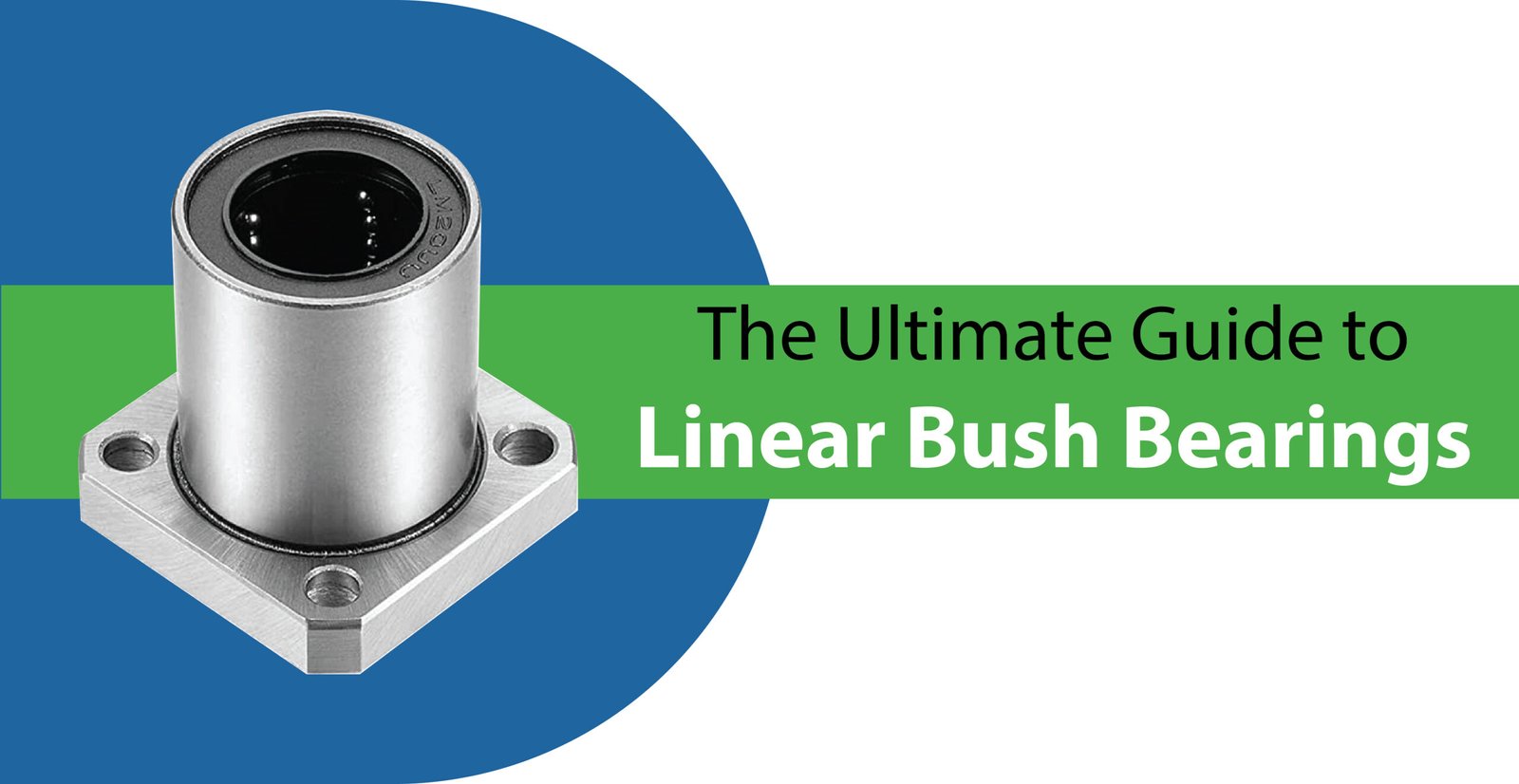The linear bush bearing, alternatively referred to as the linear ball bushing, is a kind of linear bearing that facilitates linear motion in a straight line. It is made up of a cylindrical shaft guide rail and loops of recirculating balls that run axially around it inside a cylindrical body. To facilitate the organization of ball movement, a cage is incorporated into the bearing housing. The LM shaft, which features a cylindrical shaft, is intended to function in tandem with the linear bush bearing. The bearing holds the LM shaft in place, and linear motion is produced by the balls in the bearing housing moving along the shaft. The linear bush bearing is easy to install because of its small size and straightforward design.
Linear bush bearings are commonly used in various applications that require linear motion, such as 3D printers, CNC machines, and automation equipment.
Types of Linear Bush Bearings
Linear bush bearings come in various types, each designed for specific applications and requirements. Let’s take a closer look at some of the most common types:
- Standard Linear Bush Bearings: These bearings are the most used type and are ideal for applications with moderate loads and speeds. They offer excellent performance and reliability, making them suitable for a wide range of industries.
- Flanged Linear Bush Bearings: As the name suggests, flanged linear bush bearings have a flange at one end, which helps in axial location and alignment. This type of bearing is commonly used in applications where there is a need for accurate alignment and support.
- Open Linear Bush Bearings: Open linear bush bearings are designed without seals, making them suitable for applications where debris or contamination is not a concern. They offer low friction and smooth movement, making them ideal for high-speed applications.
- Closed Linear Bush Bearings: Closed linear bush bearings have seals on both ends, providing protection against contamination. They are commonly used in applications where dirt, dust, or other particles may be present, ensuring reliable and long-lasting performance.
- Adjustable Linear Bush Bearings: Adjustable linear bush bearings allow for easy installation and fine-tuning. They offer flexibility in terms of clearance adjustment, making them ideal for applications where precise positioning is required.
Advantages of Using Linear Bush Bearings
Linear bush bearings offer a multitude of advantages that make them a popular choice in various industries. Let’s explore some of the key benefits:
- Reduced Friction: Linear bush bearings are designed to minimize friction, resulting in smoother and more efficient movement. This reduces wear and tear on the bearing and other components, leading to longer service life and improved performance.
- Increased Durability: Linear bush bearings are built to withstand heavy loads and harsh environments. They are made from high-quality materials, such as steel or bronze, which offer excellent strength and durability.
- Improved Load Capacity: Linear bush bearings can handle high loads, making them suitable for applications that require heavy-duty performance. They distribute the load evenly, minimizing stress on the bearing and ensuring reliable operation.
- Low Maintenance: Linear bush bearings require minimal maintenance, making them a cost-effective choice. They are self-lubricating or can be easily lubricated, reducing the need for regular maintenance and downtime.
- Precise Movement: Linear bush bearings provide precise and accurate movement, ensuring smooth and consistent motion. This is crucial in applications where precision is essential, such as CNC machines or robotics.
Applications of Linear Bush Bearings
Linear bush bearings find applications in various industries and systems. Here are some common examples:
- Industrial Machinery: Linear bush bearings are widely used in industrial machinery, such as conveyors, packaging equipment, and material handling systems. They provide reliable and efficient movement, improving overall system performance.
- Automotive Industry: Linear bush bearings are essential components in automotive systems, including suspension systems, steering systems, and engine components. They ensure smooth and precise movement, enhancing vehicle performance and safety.
- Medical Equipment: Linear bush bearings are used in medical equipment, such as scanning machines, surgical robots, and patient beds. They offer precise movement and durability, ensuring accurate diagnostics and reliable operation.
- Aerospace Industry: Linear bush bearings are critical in aerospace applications, where reliability and performance are paramount. They are used in aircraft landing gear, control systems, and satellite mechanisms, among others.
Also Read :- A Guide to Bearings and Bushings
Factors to Consider When Selecting Linear Bush Bearings
- Load Capacity: Determine the maximum load your application will require and choose a bearing with a suitable load capacity. Consider both static and dynamic loads to ensure optimal performance.
- Speed: Consider the speed at which your application will operate. Some bearings are better suited for high-speed applications, while others are designed for slower speeds. Choose a bearing that can handle the required speed range.
- Environment: Assess the environmental conditions your bearing will be exposed to. Consider factors such as temperature, humidity, and the presence of contaminants. Choose a bearing that is suitable for the specific environment to ensure reliable performance.
- Accuracy: Depending on your application, you may require a high level of accuracy and precision. Consider the level of accuracy your bearing needs to provide and choose accordingly.
- Installation and Maintenance: Evaluate the ease of installation and maintenance requirements of the bearing. Some bearings may require special tools or techniques for installation, while others may need regular lubrication or inspection.
- Lightweight design: Linear plain bearings have a lightweight design that allows high acceleration of the sliding elements, reducing mass inertia and decreasing wear on motors, pulleys, and other components
Installation and Maintenance of Linear Bush Bearings
- Installation: Ensure that the bearing is installed correctly, following the manufacturer’s instructions. Use the recommended tools and techniques to avoid damage to the bearing or the surrounding components.
- Lubrication: Lubricate the bearing regularly, following the manufacturer’s recommendations. Proper lubrication reduces friction and wear, extending the bearing’s service life. Use the appropriate lubricant for your specific bearing type.
- Inspection: Regularly inspect the bearing for signs of wear, damage, or contamination. Look for abnormal noise, vibration, or increased friction. If any issues are detected, take immediate action to prevent further damage.
- Cleaning: Keep the bearing and its surrounding area clean and free from debris. Regularly clean the bearing to remove any dirt, dust, or other contaminants that may affect its performance.
By following these maintenance practices, you can ensure the optimal performance and longevity of your linear bush bearings.
Comparing Linear Bush Bearings to Other Bearing Types
Let’s compare them to some commonly used bearing types:
- Ball Bearings: While ball bearings are suitable for applications with rotational motion, linear bush bearings are designed for linear motion. They provide smoother and more precise movement, making them ideal for linear applications.
- Roller Bearings: Roller bearings are typically used for heavier loads and higher speeds. However, linear bush bearings offer better precision and accuracy in linear motion applications.
- Plain Bearings: Plain bearings rely on lubrication for smooth movement, while linear bush bearings can be self-lubricating or require minimal lubrication. Linear bush bearings offer reduced friction and improved durability compared to plain bearings.
- Needle Bearings: Needle bearings are suitable for high-load applications with limited space. However, linear bush bearings offer better load distribution and improved performance in linear motion systems.
It’s important to consider the specific requirements of your application to determine the most suitable bearing type.
How to Choose the Right Linear Bush Bearing for Your Application
Choosing the right linear bush bearing for your application is essential for optimal performance. Here are some steps to guide you through the selection process:
- Identify Your Application Requirements: Determine the specific requirements of your application, such as load capacity, speed, accuracy, and environmental conditions.
- Research Available Options: Explore the different types of linear bush bearings available on the market. Consider their features, advantages, and limitations.
- Consult with Experts: Seek advice from Linear Bush bearing Manufacturer or industry experts. They can provide valuable insights and help you make an informed decision.
- Consider Cost: Evaluate the cost-effectiveness of the bearing options. Consider factors such as initial cost, maintenance requirements, and expected service life.
- Request Samples or Test Data: If possible, request samples or test data from bearing manufacturers. This will allow you to assess the performance and suitability of the bearings for your specific application.
Also Read :- Why Replacing Plastic Bushings Is Essential
Common Misconceptions
- Only for Heavy-Duty Applications: While linear bush bearings are suitable for heavy-duty applications, they can also be used in lighter-duty systems. They offer versatility and can be tailored to different load and speed requirements.
- Difficult to Install: it is easily installed with the right tools and techniques. Manufacturers provide clear installation instructions to ensure a seamless installation process.
- Require Constant Maintenance: Bush Bearings are designed to be low maintenance. While regular lubrication and inspection are necessary, they do not require constant maintenance.
- Expensive: The cost of Bearing can vary depending on the type and manufacturer. However, considering their long service life and performance benefits, they are a cost-effective choice in the long run.
Conclusion:
In conclusion, linear bush bearings are indispensable components that offer smooth and precise movement in various applications. By using this you can enjoy reduced friction, increased durability, improved load capacity, and low maintenance. These benefits make it popular choice in industries such as industrial machinery, automotive, medical equipment, and aerospace.
Microcare Techniques Private Limited is a leading Indian Liner Bush Bearing Manufacturer with over 30 years of experience. Known for their dedication and innovative vision, Microcare sets the standard for new technologies and quality benchmarks. Their expertise in crafting pump spares parts using cutting-edge methods is widely recognized. Microcare excels in delivering quality, efficiency, and on-time services. choose the right Liner Bush Bearing Manufacturer in Ahmedabad for your Business Needs.


